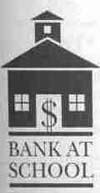Innovations
Banking on the future
Completing its first year. Bank at School is a way to teach young people money managements skills and have fun doing it. An accompanying curriculum guide is available to teachers. Lessons include a discussion of money and why people save it, what banks do and the services they offer, and how to manage budgets and credit. With the help of 170 sponsoring banks across the state, more than 45,000 students from 282 classrooms are saving money. According to the treasurer's office, current savings in more than 9.000 Bank at School accounts are over $280,000 (an average of $31.11 in each account). One school, the Falcolner School of Chicago, with all grades participating, saved $12,206.27 by April. During "bank days" students who have been trained as tellers collect deposits from fellow students. Payment for household chores is the chief source of the money deposited in the student accounts, but some schools have expanded the basic Bank at School idea to encourage entrepreneurial skills. The Bethune Elementary School in Chicago has a student-run mini-mall in a vacant classroom. Ten businesses — such as a popcorn shop, a balloon shop, a school supply store — sell to fellow students, teachers and parents during lunch hour. The students deposit 30 percent of their weekly earnings in their Bank at School accounts and invest the rest in their businesses. Now that's education they are likely to use beyond the classroom.
Touch tone renewal: convenient government service
Secretary of State George H. Ryan's new driver's license renewal system is an example. It's as easy as dialing your phone. Called "Touch-Tone Renewal," this automated system allows drivers to renew all car, small truck or motorcycle renewal stickers by calling a toll-free number (1-800-664-1212) any time of day, seven days a week. After a six-month trial run, the system began statewide in June. Callers dial in, place their order and pay for it with a bank credit card. The whole transaction takes about five minutes. About a million vehicle owners used the touch-tone option for license renewal during the trial period. Ryan said the system was used every hour of every day including holidays, with calls coming from as far away as Florida, Texas and Arizona. "People who spend extensive periods of time out of state — either on vacation, at school or in the military — now have this service at their fingertips," said Ryan. But the heaviest users were commuters in the suburban areas around Chicago, where many people leave before offices open and return home after they close. In addition to the service, Ryan says the touch-tone renewal system is cost-efficient government (again, the term isn't always an oxymoron). Processing credit card transactions is cheaper than processing checks. All the money taken in through credit cards is on deposit the next day, earning money for the state treasury at the earliest opportunity. In its first six months, the system handled more than 25,000 renewals and netted Ryan's office nearly $1.2 million in revenue, mainly because it didn't cost anything to start. Ryan says contractors — Harris Bank Charge-It Systems in conjunction with Ameritech — paid all startup costs, installed the equipment and provided training for the staff. The contractors are paid back through a $2.50 handling fee charged to users of the system. A similar system is in place at the Illinois Department of Conservation to renew boat and snowmobile registration. Call 1-800-867- 3542; have your current registration handy.
Saved by the balI: Illinois wildlife
has a new friend
Preservation Fund for each ball sold. Oliver Sporting Goods will underwrite production expenses. The sports balls, which include soccer balls, volleyballs, footballs, basketballs and playground balls, will be marketed to museum and zoo shops, theme parks, stores and schools. The conservation agency will help market the balls by making people aware of their availability. A spokeswoman for the sporting goods company says that the balls will help school children recognize state symbols and understand the importance of conserving our native species. Glimmer of hope: new furnace uses high sulfur coal One of the state's great ironies is that it sits on a vast natural fuel that cannot be used to its full potential because of its high sulfur content. Markets — and consequently thousands of jobs — are lost to out-of-state, and increasingly out-of-country, suppliers of low sulfur coal. There is a real race to see if technology can find ways to use Illinois coal before all the mines shut down for lack of buyers.
A new furnace that uses high sulfur coal in a liquid form while remaining within compliance of the federal clean air requirements may recapture markets lost to oil and gas companies. Developed by Tecogen Inc., a Massachusetts high-tech research and development firm, the experimental furnace completed a successful six-month trial warming the 17,654-square-foot high-bay research building at the Illinois Coal Development Park in Carterville. John Mead, director of Southern Illinois University at Carbondale's Coal Research Center, says the furnace uses a fuel called coal slurry, a mixture of pulverized coal and water that is easy to make, use and store. This is not new. The hangup has been an efficient and — since the passage of the Clean Air Act amendments of 1992 — clean-burning furnace. Mead says the initial results of the test show the furnace to be "extremely efficient" in controlling sulfur dioxide and other undesirable emissions. The high-tech furnace is about the same size as a conventional business furnace and works well in small factories, schools, malls, large department stores and hospitals. These are the niche markets Illinois coal used to claim. The Tecogen furnace and Illinois coal technology researchers may help get them back. Beverley Scobell August 1994/Illinois Issues/33
|
|||||||||||||||



